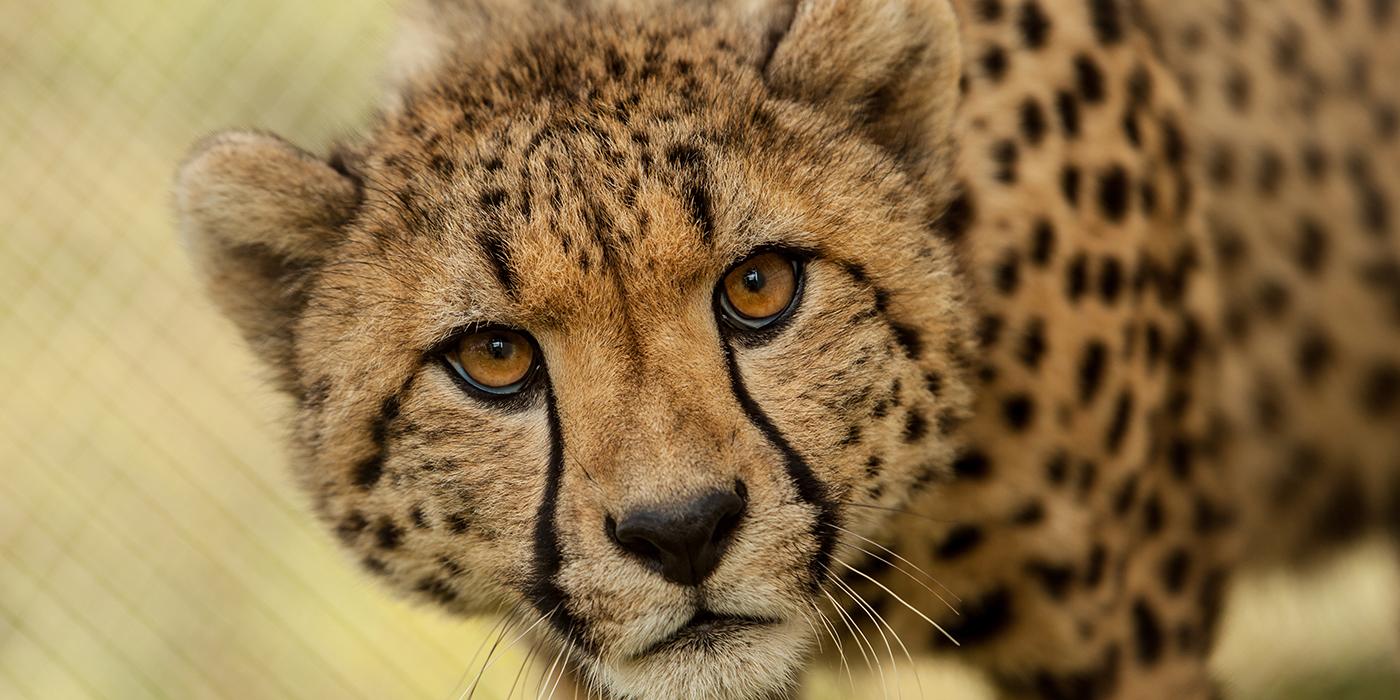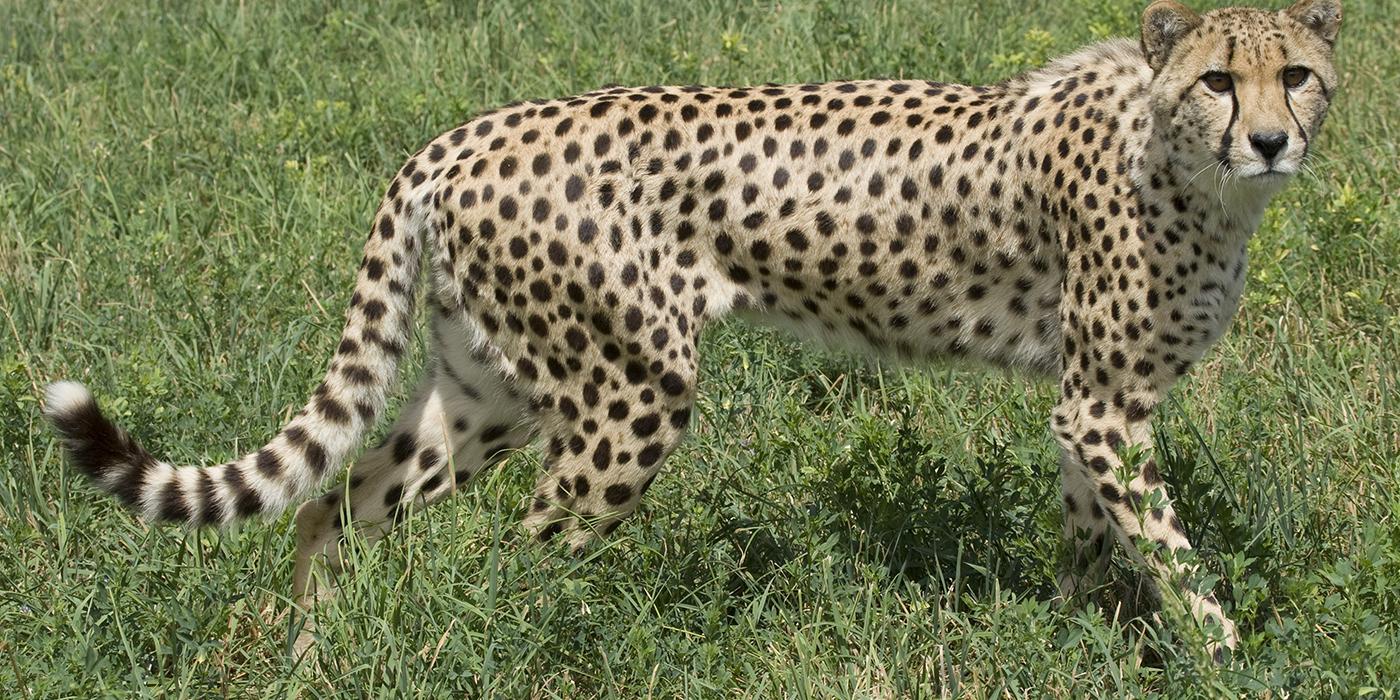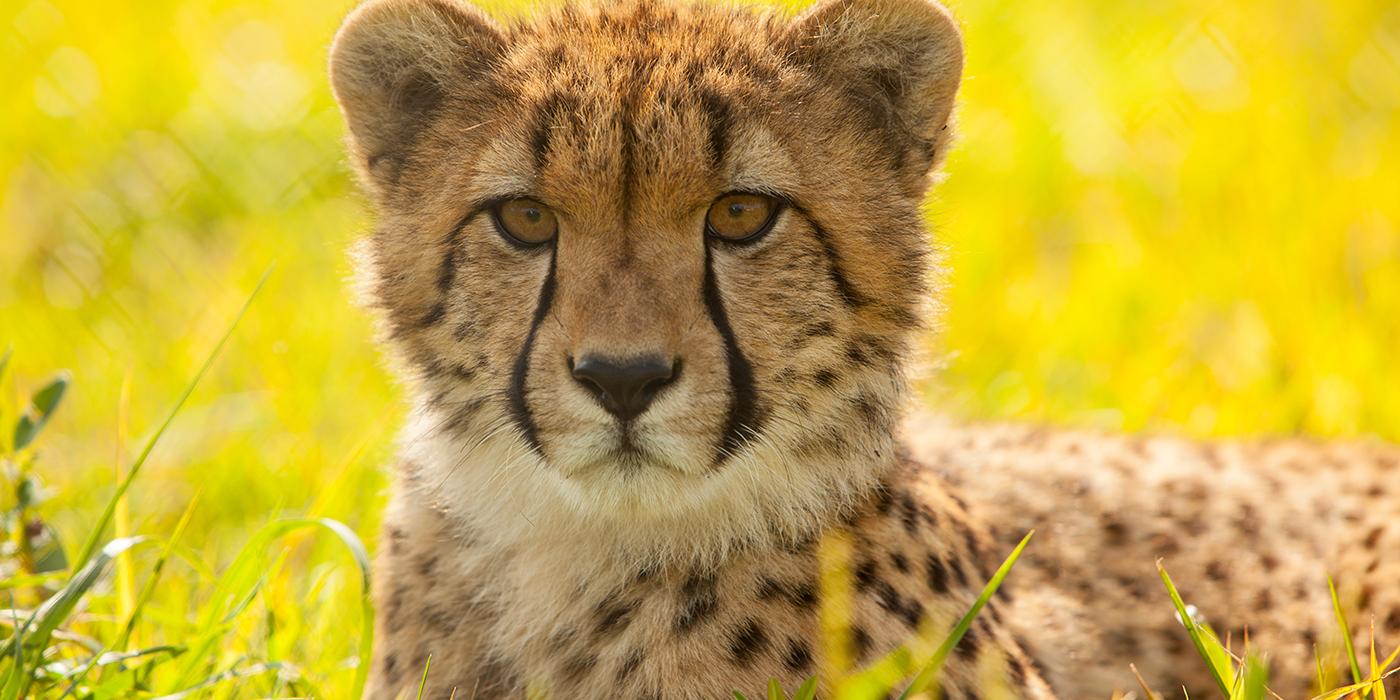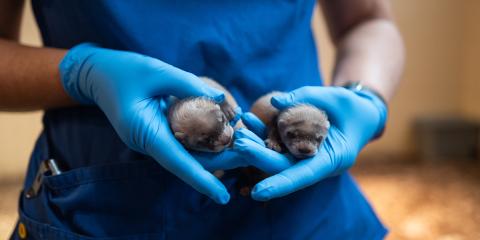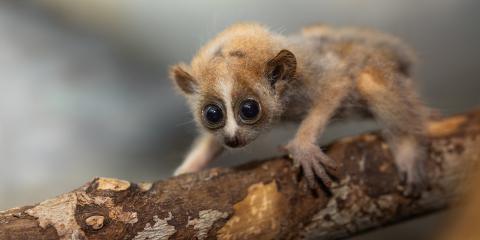Built for speed, the cheetah can accelerate from zero to 45 in just 2.5 seconds and reach top speeds of 60 to 70 mph, making it the fastest land mammal! The cheetah's spotted coat helps it camouflage among the dry grasses of the African savanna where it lives.
Physical Description
Cheetahs have slender, long-legged bodies with blunt, semi-retractable claws. Their heads are small with high-set eyes. A black tear mark runs from the inner corner of each eye down to the mouth. A cheetah's teeth are small when compared with other big cats, which accommodates their larger nasal passages that enable quick air intake.
Adults have yellow or tan short, coarse fur with solid black round or oval spots measuring 0.75 to 1.5 inches (1.9 to 3.8 centimeters) in diameter. The spots cover nearly the entire body; only the white throat and belly are unmarked. The tail ends with four to six black rings and a bushy white or black tuft.
Cheetahs' spots may serve as camouflage for both hunting and hiding. Their spots may offset the shadows in the gray-hued grasses they often inhabit, allowing them to blend in with their surroundings. Camouflage is essential not only for stalking prey, but also for protecting cheetah cubs from predators. A cheetah cub's smoky gray mantle may serve as added camouflage among dead grasses. Much like a human fingerprint, a cheetah's spots and the ring pattern of its tail are unique, enabling researchers in the field to identify individuals.
Cheetahs are aerodynamically built for speed and are the fastest land mammal. At top speed, they advance 23 feet (7 meters) in a single stride and complete four strides per second. That top speed averages between 60 and 70 miles per hour (96 and 112 kilometer per hour) and can be maintained for only about 300 yards (274 meters). Cheetahs can accelerate from zero to 45 miles per hour (zero to 72 kilometers per hour) in just 2.5 seconds. No other land mammal surpasses their short sprints.
Special paw pads and semi-retractable claws provide great traction. Large nostrils and lungs provide quick air intake that allows cheetahs to breathe more easily while running and suffocating their prey. A large liver, heart and adrenal gland facilitate a rapid physical response. A greyhound-like body is streamlined over light bones. Cheetahs have small collarbones and vertical shoulder blades, which are not attached to the collarbone, as well as hips that swivel on a flexible spine. These structural adaptations help lengthen their stride and provide superior acceleration. The cheetah's tail acts as a rudder for quick turning, counteracting its body weight.
Cheetahs' eyes have elongated retinal foveas (the small, rodless areas of the retina), giving them a sharp, wide-angle view of their surroundings. Their small, flat-faced heads allow their eyes to be positioned for maximum binocular vision. The dark tear marks beneath each eye may aid in hunting by minimizing the sun's glare. They may also provide an enhanced ability to intimidate. A cheetah's spine works as a spring for its powerful back legs, extending the cheetah's reach with each step, but the movement is physiologically taxing.
Cheetahs pay a price for their speed. Their large nasal passages leave little room for the long roots required to anchor big teeth. Without large teeth, cheetahs' fighting abilities are limited. Larger, stronger cats like lions easily overwhelm them, so cheetahs tend to opt for flight versus fight. Because of their short teeth, cheetahs must kill prey by suffocation.
Size
An adult cheetah weighs 75 to 140 pounds (34 to 64 kilograms), is about 30 inches (77 centimeters) tall at the shoulder and 44 to 56 inches (112 to 142 centimeters) long with another 26 to 33 inches (66 to 84 centimeters) in tail length. Males are slightly larger than females. Cheetahs are sometimes confused with leopards—a much heavier animal with rosette-shaped spots and no tear marks.
Native Habitat
Cheetahs inhabit a broad section of Africa including areas of North Africa, the Sahel, eastern and southern Africa. Over the past 50 years, cheetahs have become extinct in at least 13 countries, and they are most prevalent in Kenya and Tanzania in east Africa, and Namibia and Botswana in southern Africa. The Asiatic cheetah is known to survive in Iran, but is critically endangered. Cheetahs thrive in areas with vast expanses of land where prey is abundant. In Namibia, cheetahs live in a variety of habitats, including grasslands, savannahs, dense vegetation and mountainous terrain. As human development expands in to their preferred habitat, cheetahs can now commonly be found on commercial farms.
Lifespan
The average lifespan of wild cheetahs is 8 to 10 years. In human care, the average lifespan is 12 to 15 years.
Communication
Cheetahs do not roar, but they make sounds including purrs, barks, growls, hisses and chirps that are unlike those of any other cat. The most common vocalization is the chirp. Another common vocalization is what has been termed the "eeaow." It is a lot like the meow of a cat, but does not have the initial low frequency. Another common vocalization is the stutter, which appears to be a direct solicitation. Males stutter when it appears that there is a high level of excitement and/or arousal toward a female. Females stutter toward cubs when they either want them to stay put or to follow her.
Common vocalizations:
- Chirping: Similar to a bird's chirp or a dog's yelp, an intense chirp can be heard a mile away. Estrus females chirp to attract males. Both sexes chirp when distressed. Males may chirp when separated from members of their coalition and may chirp when reunited; mom and cubs will do the same. In a study conducted at the Smithsonian's National Zoo in 2001, chirping sounds varied from individual to individual indicating that cheetahs may be able to identify each other by chirps alone.
- Stuttering: Staccato (short, disconnected) moan that sounds like a pigeon cooing
- Purring: Similar to a house cat's purring. A close-range vocalization that may suggest contentment. It can be heard between mother and cubs. It is unusual in that it may go on for minutes and is produced continuously both while the cat inhales and exhales. In "Smithsonian Answer Book: Cats," Seidensticker and Lumpkin quote Gustav Peters as saying that "the body surface vibration during purring may serve as a tactile signal in addition to the auditory one," especially because cats are generally in close proximity to each other when purring.
- Yelping: Loud chirp, desperate call to locate another cheetah.
Food/Eating Habits
Cheetahs are carnivorous and eat a variety of small animals. While most cats are nocturnal predators, cheetahs are primarily diurnal, hunting in the early morning and late afternoon. Since they depend on sight more heavily than smell, they like to scan the countryside from a kopje, or the top of a termite mound. Cheetahs usually creep within 100 yards (91.4 meters) of an intended victim before the final acceleration. Full sprints last about 20 seconds.
Cheetahs eat small antelope including springbok, steenbok, duikers, impala and gazelles, as well as the young of larger animals including warthog, kudu, hartebeest, oryx, roan and sable. They also eat game birds and rabbits.
About half a cheetah's prey chases are successful. If successful in catching an animal, cheetahs suffocate their prey by clamping down on the animal's windpipe. The jaw structure of a cheetah can create a vise-like grip. Very small animals, like hares, are killed by a simple bite through the skull. But whatever the meal, large or small, cheetahs eat quickly, as they can be bullied away from their catch by lions, hyenas, and sometimes groups of vultures. Cheetahs lose about 50 percent of their food this way. Cheetahs have unusually clean eating habits: they do not return to their kill nor do they eat carrion. They leave the bones and entrails of their prey. At six weeks, the young are strong enough to follow the hunt and when they are about six months old the mother will capture live prey for them to practice killing.
Cheetahs at the Zoo are fed 3.5 pounds of ground beef each day. Frozen rabbits and beef femurs are sometimes given for enrichment. The cheetahs are fed twice a day—a morning feeding and an afternoon/evening feeding.
Sleep Habits
Primarily diurnal, unlike many other species of cats.
Social Structure
Cheetahs have a unique social order among felids. Adult females are solitary, while adult males are not. Adult females interact with adult males only long enough to breed, and females raise their cubs on their own. At 18 months, the mother leaves the cubs, who then form a sibling group that stays together for another six months. At about two years, the female siblings leave the group and become solitary, while the young males remain together for life in a group called a coalition. A coalition is usually made up of two to three littermates and is a very tightly bonded group. Singleton males are not common and usually do not survive long. This coalition will live and hunt together for life claiming a territory, which may encompass several female home ranges.
Around the age of two, when males reach sexual maturity, they seek out an area far away from their parent, sometimes as far as 300 miles (482 kilometers). The size of male territories is usually five to 10 square miles (13 to 26 square kilometers) although it may extend up to 50 square miles (130 square kilometers). Coalitions will claim a territory in an environment that is likely to attract herds of gazelles, for instance, one near water.
Young females, however, usually occupy the same range as their mother, although all females are solitary except when they have a litter. Female home ranges can be from 322 to 370 square miles (833 to 958 square kilometers) and follow migratory gazelle herds. Several female ranges may overlap due to scarce resources during the dry season. Females may encounter one another with little or no aggression during this time.
Reproduction and Development
Sexual maturity occurs at 18 to 23 months. The gestation period is about three months, and the average litter size is three to six cubs. While there is no definitive breeding season, a majority of births occur during the wet season. Births occurring during this time of year coincide with the gazelle birth season, increasing food resources for the cheetah.
Cubs are smoky-grey in color with long hair, called a mantle, running along their backs. They are about 12 inches (30 centimeters) long and weigh nine to 12 ounces (400 grams) on average at birth. Cub mortality is high in both the wild and captivity. On average 30 percent of all cubs born in human care die within one month of birth, and in Tanzania's Serengeti National Park, about 90 percent die before reaching three months of age.
At six weeks, the young are strong enough to follow the hunt and when they are about six months old the mother will capture live prey for them to practice killing.
Conservation Efforts
Historically, cheetahs ranged widely throughout Africa and Asia, from the Cape of Good Hope to the Mediterranean, throughout the Arabian Peninsula and the Middle East, from Israel, India and Pakistan north to the northern shores of the Caspian and Aral Seas, and west through Uzbekistan, Turkmenistan, Afghanistan, and Pakistan into central India. There were approximately 100,000 cheetahs in 1900, distributed throughout western Asia and Africa.
Over the past 50 years, cheetahs have become extinct in at least 13 countries. The Asiatic cheetah (A. j. venaticus) survives in Iran, but is critically endangered.
An estimated 7,500 to 10,000 cheetahs remain in the wild. The largest population, 2,500, is found in Namibia, with Southern Africa as the last remaining stronghold of roughly 4,500 adults.
Help this Species
- Reduce, reuse and recycle — in that order! Cut back on single-use goods, and find creative ways to reuse products at the end of their life cycle. Choose recycling over trash when possible.
- Support organizations like the Smithsonian’s National Zoo and Conservation Biology Institute that research better ways to protect and care for this animal and other endangered species. Consider donating your time, money or goods.
- Share the story of this animal with others. Simply raising awareness about this species can contribute to its overall protection.
